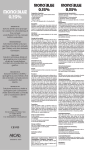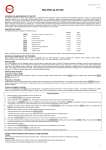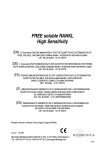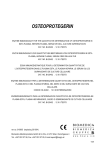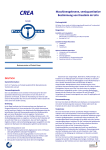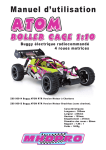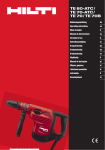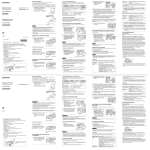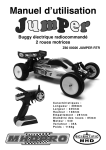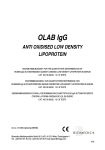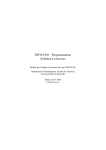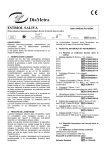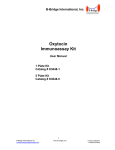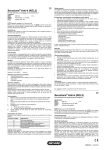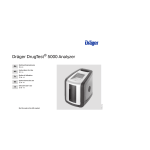Download ENDOTHELIN (1-21)
Transcript
ENDOTHELIN (1-21) (EN) ENZYME IMMUNOASSAY FOR THE QUANTITATIVE DETERMINATION OF HUMAN ENDOTHELIN (1-21) IN SERUM, EDTA PLASMA, URINE, SALIVA AND CELL CULTURE SUPERNATANTS. CAT. NO. BI-20052. 12 X 8 TESTS (DE) ENZYMIMMUNOASSAY ZUR QUANTITATIVEN BESTIMMUNG VON HUMAN ENDOTHELIN (121) IN SERUM, EDTA PLASMA, URIN, SPEICHEL UND ZELLKULTURÜBERSTAND. KAT. NR. BI-20052. 12 X 8 TESTE (FR) DOSAGE IMMUNOENZYMATIQUE POUR LA DÉTERMINATION QUANTITATIVE D’ENDOTHELINE HUMAINE (1-21) DANS LE SÉRUM, LE PLASMA EDTA, L’URINE, LA SALIVE ET LES SURNAGEANTS DE CULTURE CELLULAIRE CAT. NO. BI-20052. 12 X 8 TESTS (ES) ENZIMOINMUNOENSAYO PARA LA DETERMINACION CUANTITATIVA DE ENDOTELINA HUMANA(1-21) EN SUERO, PLASMA EDTA, ORINA , SALIVA Y EN SOBRENADANTE DE CULTIVOS CELULARES CAT. NO. BI-20052, 12 X 8 TESTS rev.no. 120216 (replacing 090701) Biomedica Medizinprodukte GmbH & Co KG, A-1210 Wien, Divischgasse 4 Tel. +43/1/291 07 45, Fax +43/1/291 07 85, E-mail [email protected] 1/24 CONTENT / INHALT / SOMMAIRE / CONTENIDO 1. 2. 3. 4. ENGLISH ......... 3 DEUTSCH ........ 9 FRANCAIS ….… 13 ESPANIOL …… 18 Additional information on our products is available on our website. Zusätzliche Information zu unseren Produkten ist auf unserer Homepage erhältlich Des informations complémentaires figurent sur notre site Web. Encontrará información adicional sobre nuestros productos en nuestra página web. www.bmgrp.com 2/24 1) INTRODUCTION Cleavage of Big Endothelin by a membrane-bound metalloproteinase, the Endothelin Converting Enzyme (ECE) leads to the active ET (1-21), a potent vasoconstrictor, and to the biological inactive C-terminal fragment (22-38). The half-life of ET in the plasma is less than one minute, whereas clearance of Big ET is much slower. Endothelin has been identified in a variety of tissues, including lung, kidney, brain, pituitary and peripheral endocrine tissues and placenta. The biological role of ET extends beyond regulating vascular tone also in its growth regulatory properties. The peptide interacts in an autocrine/paracrine manner with specific ET receptors found on numerous cells, including smooth muscle cells, myocytes, and fibroblasts. Indications Heart failure and acute myocardial infarction Oncology Marker for endothelial dysfunction, liver damage and renal disease Hypertension 2) CONTENTS OF THE KIT CONT KIT COMPONENTS Polyclonal anti Endothelin antibody, microtiter plate strips in stripholder PLATE packed in aluminium bag with desiccant WASHBUF Wash buffer concentrate 20x, natural cap Detection antibody, monoclonal mouse anti Endothelin antibody, green AB cap, ready to use Standards ( 0-10 fmol/ml), synthetic human Endothelin-1 (1-21) in human STD serum, white caps, lyophilised Controls, synthetic human Endothelin-1 (1-21) in human serum, yellow CTRL caps, lyophilised, exact concentration after reconstitution see label CONJ Conjugate (anti mouse IgG antibody-HRPO), amber cap, ready to use SUB Substrate (TMB solution), blue cap, ready to use STOP Stop Solution, white cap, ready to use Endothelin Stock, synthetic human Endothelin-1 (1-21), lyophilised, red ET-STOCK cap, exact concentration after reconstitution see label QUANTITY 12 x 8 tests 1 x 50 ml 1 x 22 ml 6 vials lyophilised 2 vials lyophilised 1 x 22 ml 1 x 22 ml 1 x 7 ml 1 vial lyophilised 3) ADDITIONAL MATERIAL ADDED TO THE KIT 2 self-adhesive plastic films QC protocol Protocol sheet Instruction manual for use 4) MATERIAL AND EQUIPMENT REQUIRED BUT NOT SUPPLIED Precision pipettes calibrated to deliver 50µl, 200µl, 300µl, 500µl and disposable tips ELISA reader for absorbance at 450 nm (reference 630 nm) Graph paper or software for the calculation of results Distilled or deionised water 3/24 5) REAGENTS AND SAMPLE PREPARATION A ll reagents of the kit are stable at 4°C (2-8°C) until expiry date stated on the label of each reagent. Sample preparation: Serum, EDTA plasma, urine, saliva and cell culture supernatants are suitable for use in this assay. Don’t change sample type during studies. Freshly collected EDTA plasma or serum is put on ice immediately and centrifuged within one day. Samples should be stored at -25°C or lower, for long-term storage store at -70°C. Urine samples can be used without any pre-treatment. Avoid freeze-thaw cycles. Lipemic or hemolyzed samples may give erroneous results. Samples should be mixed well before assaying. We recommend duplicates for all values. If it is necessary to dilute samples with a high concentration please use 0.9% sodium chloride solution. For further information on sample stability please visit our www.bmgrp.com technical file or contact our customer service by e-mail [email protected] or by phone +43/ 1/ 29107-45. Reconstitution/Handling: STD (Standards, white caps) in 0.5ml distilled water, at room temperature (18-26°C) for 30 min, shake well. Reconstituted standards are stable at -25°C or lower until expiry date stated on label. Avoid repeated freeze-thaw cycles! CTRL (Controls, yellow caps) in 0.5 ml distilled water at room temperature (18-26°C) for 30 min, shake well. Reconstituted controls are stable at -25°C or lower until expiry date stated on label. Avoid repeated freeze-thaw cycles! WASHBUF (Wash buffer) dilute the concentrate 1:20 with distilled water (50 ml concentrate + 950 ml distilled water). Crystals in the buffer concentrate will dissolve at room temperature. Buffer is stable at 2-8°C until expiry date stated on label. ET-STOCK (Endothelin stock, red cap): Direct measurement of Endothelin in cell culture supernatants. Reconstitute in 2 ml cell culture medium at room temperature (18-26°C) for 30 min, shake well. Exact concentration after reconstitution see label, eg. 10 fmol/ml. Reconstituted ET stock is stable at -25°C or lower until expiry date stated on the label. Avoid repeated freeze-thaw cycles. Measurement of Cell culture samples: Do not use the plasma-standards (white caps) and controls (yellow cap)! Prepare a serial dilution of the cell culture ET-STOCK (Endothelin- stock, red cap) with cell culture medium down to appr. 0.625 fmol/ml (e.g. 10 / 5 / 2.5 / 1.25 / 0.625 fmol/ml). Cell culture medium is used as a zero standard. Dilute cell culture supernatant according to the expected concentration with the culture medium. Dilution of supernatant is dependent on amount of Endothelin secreted by the respective cell type. Measurement of saliva samples: For sample collection we recommend Sarstedt Salivettes. Sample collection: Last meal or cigarette should have been consumed at least one hour before sample collection. Rinse mouth with water, wait 10 minutes. Put cotton roll of the Sarstedt Salivette tube into the mouth, chew for 30 sec., keep in mouth for two additional minutes. Place the cotton roll into the flat bottom upper tube of the Salivette, seal with the stopper and centrifuge for 3 min. at 1000 rcf (rotational centrifugal force = g). Remove the flat bottom tube from the Salivette and pipette the clear saliva from the bottom of the V-tube, aliquot and store at -25°C or lower. Use the clear saliva according to the assay protocol. 4/24 6) PRINCIPLE OF THE ASSAY 7) ASSAY PROTOCOL All reagents and samples must be at room temperature (18-26°C) before use in the assay. Mark position for BLANK/STD (Standards)/SAMPLE/CTRL (Control) on the supplied protocol sheet. Take microtiter strips out of the aluminium bag, take a minimum of one well as Blank. Store unused strips with desiccant at 2-8°C in the aluminium bag. Strips are stable until expiry date stated on the label. 1. 2. 3. 4. Add 50 µl STD/SAMPLE/CTRL (Standard/Sample/Control) in duplicate into respective well, except blank. Add 200 µl AB (Detection antibody) into each well, except blank, swirl gently. Cover tightly and incubate overnight (16-24 hours) at room temperature (18-26°C). Aspirate and wash wells 5x with 300 µl diluted WASHBUF (Wash buffer), remove remaining WASHBUF by hitting plate against paper towel after the latest wash. 5. Add 200 µl CONJ (Conjugate) into each well. 6. Cover tightly and incubate 1 hour at room temperature (18-26°C). 7. Aspirate and wash wells 5x with 300 µl diluted WASHBUF (Wash buffer), remove remaining WASHBUF by hitting plate against paper towel after the last wash. 8. Add 200 µl SUB (Substrate) into each well. 9. Incubate for 30 minutes at room temperature (18-26°C) in the dark. 10. Add 50 µl STOP (Stop solution) into each well, shake well. 11. Measure absorbance immediately at 450 nm with reference 630 nm, if available. 8) CALCULATION OF RESULTS S ubtract the blank extinction from all other values. Construct the standard curve from the standard values. Use commercially available software or graph paper. Obtain sample concentration from this calibration curve. The assay has been evaluated using a 4PL algorithm. Different curve fitting methods need to be evaluated by the user. Respective dilution factors have to be considered. Example typical STD-curve: 5/24 The quality control protocol supplied with the kit shows the results of the final release QC for each kit. Data for optical density obtained by customers may differ due to various influences and/or due to the normal decrease of signal intensity during shelf life. However, this does not affect validity of results as long as an optical density of 1.50 or higher is obtained for the standard with the highest concentration. 9) ASSAY CHARACTERISTICS Values from apparently A panel of 70 blood donors had a median of 0.26 fmol/ml. healthy individuals: Each laboratory should establish its own reference data. Standard range: 0-10 fmol/ml Sample volume 50 µl human EDTA plasma, serum, urine, saliva or cell culture supernatant Detection Limit: (0 fmol/ml + 3 SD): 0.02 fmol/ml Incubation time: overnight / 1 h / 30 min Cross reactivity: ET(1-21): 100%, ET2 (1-21): 100%, ET3 (1-21): <5%, Big Endothelin (1-38): <1%, Big Endothelin ( 22-38): <1% In normal human plasma samples ET-2 is estimated to be present at less than 20% of the ET-1 level. ET-3 is estimated to be present at 50% of the ET-1 level. Animal sera: Horse, cat, pig 100%; dog 66% and rat 79%, Mouse sera can not be measured in this ELISA. Recovery (n = 4) Recovery (fmol/ml) Recovery (%) Spike 1 fmol/ml 0.96 96% Spike 5 fmol/ml 4.3 86% For further information on assay characteristics please visit our website www.bmgrp.com technical file or contact our customer service by e-mail [email protected] or by phone +43/ 1/ 29107-45. 10) PRECISION Intra-Assay: 2 samples of known concentrations were tested 18 times Inter-Assay: 2 samples of known concentrations were tested in different assays 24 times Intra-Assay (n=18) Inter-Assay (n=24) Mean (fmol/ml) 2.02 7.01 Mean (fmol/ml) SD 0.08 0.21 SD CV% 4% 3% CV% 3.8 0.2 6% 0.8 0.04 5% 11) TECHNICAL HINTS Do not mix or substitute reagents with those from other lots or sources. Do not mix stoppers and caps from different reagents or use reagents between lots. Do not use reagents beyond expiration date. Protect reagents from direct sunlight. Substrate solution should remain colourless until added to the plate. To ensure accurate results, proper adhesion of plate sealers during incubation steps is necessary. 6/24 12) PRECAUTIONS All test components of human source were tested with 3rd generation tests against HIV-Ab and HBsAg and were found negative. Nevertheless, they should be handled and disposed as if they were infectious. Liquid reagents contain ≤0.1% Proclin 300 as preservative. Proclin 300 is not toxic in concentrations used in this kit. It may cause allergic skin reactions – avoid contact with skin or eyes. Do not pipette by mouth. Do not eat, drink, smoke or apply cosmetics where reagents are used. Avoid all contact with the reagents by using gloves. Sulfuric acid is irritating to eyes and skin. Flush with water if contact occurs. Avoid contact with skin and mucous. Irritations are possible – Flush with water after contact! 13) LITERATURE “Plasma levels of endothelin, lipid peroxides and prostacyclin in diabetic patients with macroangiopathy” Migdalis IN et al.; Diabetes Res Clin Pract 2001 Nov;54(2):129-36 “Plasma endothelin in patients with acute aortic disease” Wagner A et al.; Resuscitation 2002 Apr;53(1):71-6 “Plasma endothelin-1 levels and clinical correlates in patients with chronic heart failure” Kinugawa T et al.; J Card Fail 2003 Aug;9(4):318-24 7/24 8/24 1) EINLEITUNG Die Spaltung von Big Endothelin-1 (Big ET) durch eine membrangebundene Metalloendopeptidase, das Endothelin Converting Enzyme (ECE), führt zum aktiven ET (1-21), einem potenten Vasokonstriktor, und dem biologisch inaktiven C-terminalen Fragment (22-38). Die Halbwertszeit von ET in Plasma beträgt weniger als eine Minute während die „Clearance“ von Big ET deutlich langsamer ist. Endothelin wurde in in einer Vielzahl von Geweben wie der Lunge, der Niere, dem Gehirn, im Speichel, peripheren endokrinem Gewebe und der Plazenta gefunden. Die biologische Rolle von ET geht über die Regulierung des vaskulären Tonus hinaus und umfasst auch wachstumsregulierende Eigenschaften. Das Peptid reagiert in einer autokrinen / parakrinen Weise mit spezifischen ET Rezeptoren an verschiedensten Zellen wie Zellen der glatten Muskulatur, Myozyten und Fibroblasten. Indikationen Herzversagen und Herzinfarkt Onkologie Marker für endotheliale Dysfunktion, Leberschaden und Nierenerkrankungen Hypertonie 2) INHALT DES KITS CONT KIT KOMPONENTEN Polyklonaler anti Endothelin Antikörper, beschichtet auf PLATE Mikrotiterplattenstreifen im Streifenhalter. Verpackt im Aluminiumsäckchen mit Trockenmittel. WASHBUF Waschpuffer, 20fach Konzentrat, durchsichtige Kappe AB Monoklonal Maus anti Endothelin Antikörper, grüne Kappe, gebrauchsfertig Standards (0-10 fmol/ml), synthetisches human Endothelin-1 (1-21) in STD human Serum, weisse Kappen, lyophilisiert. Kontrollen, synthetisches humanes Endothelin-1 (1-21) in human Serum, CTRL gelbe Kappen, lyophilisiert, genaue Konzentration nach Rekonstitution siehe Etikett. Konjugat, (anti Maus IgG Antikörper-HRPO), braune Kappe, CONJ gebrauchsfertig SUB Substrat (TMB Lösung), blaue Kappe, gebrauchsfertig STOP Stopp Lösung, H2SO4, weisse Kappe, gebrauchsfertig Endothelin Stock, synthetisches human Endothelin-1 (1-21) in Puffer, rote ET-STOCK Kappe, lyophilisiert, genaue Konzentration nach Rekonstitution siehe Etikett MENGE 12 x 8 Teste 1 x 50 ml 1 x 22 ml 6 x lyophilisiert 2 x lyophilisiert 1 x 22 ml 1 x 22 ml 1 x 7 ml 1 x lyophilisiert 3) ZUSÄTZLICHES MATERIAL IM KIT 2 selbstklebende Abdeckfolien QC Protokoll Arbeitsanleitung (Beipacktext) Protokoll Blatt 4) ZUSÄTZLICH BENÖTIGTES MATERIAL UND GERÄTE Kalibrierte Präzisionspipetten für 50µl, 200µl, 300µl, 500 µl, inkl. Pipettenspitzen Mikrotiterplattenphotometer mit 450 nm Filter (630 nm Referenz) Millimeterpapier oder Software Destilliertes oder deionisiertes Wasser 9/24 5) REAGENZIEN UND PROBENVORBEREITUNG A lle Reagenzien des Kits sind bei 4°C (2-8°C) bis zum Ablaufdatum (siehe Etikett des Reagenz) stabil. Probenvorbereitung: In diesem Test können Serum, EDTA Plasma, Harn, Speichel und Zellkulturüberstände gemessen werden. Vermeiden Sie, die Probenmatrix während einer Studie zu wechseln. Frisch abgenommenes Serum oder EDTA Plasma wird sofort auf Eis gestellt und innerhalb eines Tages abzentrifugiert. Proben sind bei -25°C oder tiefer zu lagern.. Urinproben können ohne Vorbehandlung direkt gemessen werden. Vermeiden Sie Frier-Tau Zyklen, bis maximal 4 Zyklen sind möglich. Lipämische oder hämolysierte Proben können zu fehlerhaften Ergebnissen führen. Vor dem Einsatz im Test Proben gut mischen. Wir empfehlen, alle Werte in Doppelbestimmungen durchzuführen. Falls es notwendig ist, hohe Proben zu verdünnen, verwenden Sie 0,9% NaCl-Lösung. Nähere Informationen zur Probenstabilität finden sie auf unserer Website unter www.bmgrp.com technical file oder Sie kontaktieren unser Kundenservice, Email unter [email protected], Tel. unter +43/ 1/ 29107- 45. Rekonstiturtion/Handhabung: STD (Standards, weisse Kappe): Lösen Sie die Standards in jeweils 0,5 ml destilliertem Wasser bei Raumtemperatur (18-26°C) für 30 min., gut mischen. Die Lösung ist bei -25°C oder tiefer bis zum Ablaufdatum haltbar. Vermeiden Sie Frier-Tau Zyklen. CTRL (Kontrollen, gelbe Kappen): Lösen Sie das Lyophilisat in 0,5 ml destilliertem Wasser bei Raumtemperatur (18-26°C) für 30 min., gut mischen. Die Lösung ist bei -25°C oder tiefer bis zum Ablaufdatum haltbar. Vermeiden Sie Frier-Tau Zyklen. WASHBUF (Wasch Puffer): Das mitgelieferte Konzentrat wird 1:20 verdünnt (z.B. 50 ml WASHBUF + 950 ml destilliertes Wasser). Kristalle im Pufferkonzentrat lösen sich bei Raumtemperatur auf. Der verdünnte Puffer ist bei 2-8°C bis zum Ablaufdatum haltbar. Im Testsystem darf nur verdünnter WASHBUF (Waschpuffer) verwendet werden. ET-STOCK (Endothelin stock, rote Kappe). Bestimmung von Endothelin in Zellkulturüberständen: Lösen Sie das Lyophilisat in 2 ml Zellkulturmedium bei Raumtemperatur (18-26°C) für 30 min., gut mischen. Genaue Konzentration nach Rekonstitution siehe Etikett, z.B. 10 fmol/ml. Der rekonstituierte ET-STOCK ist bei -25°C oder tiefer bis zum Ablaufdatum haltbar. Vermeiden Sie Frier-Tau Zyklen. Messung von Zellkulturproben: STD und CTRL (Plasma Standard, weiße Kappen und Kontrolle, gelbe Kappe) nicht verwenden. Mit dem rekonstituierten Zellkultur ET-STOCK (Endothelin-1 stock) eine Verdünnungsreihe bis etwa 0,625 fmol/ml in Zellkulturmedium herstellen.(z.B. 10 / 5 / 2,5 / 1,25 / 0,625 fmol/ml). Verwenden Sie Zellkulturmedium als 0 Standard. Verdünnen Sie die Zellkulturüberstände je nach erwarteter Endothelin Konzentration mit Zellkulturmedium. Messung von Speichelproben: Zur Probennahme empfehlen wir Sarstedt Salivette. Eine Stunde vor Probennahme nicht rauchen und nicht essen! Probennahme: Mund mit Wasser ausspülen, 10 min warten Die Baumwollrolle der Salivette in den Mund nehmen, 30 Sek. kauen, dann für 2 Minuten im Mund behalten Baumwollbausch in das mitgelieferte Röhrchen plazieren, mit dem Stoppel verschließen und 3 Minuten bei 1000g zentrifugieren Überstand abheben, wenn nötig aliquotieren und bei -25°C oder tiefer lagern. Überstand direkt im Test einsetzen. 10/24 6) TESTPRINZIP Siehe Kapitel 6) PRINCIPLE OF THE ASSAY im englischen Teil des Beipacktextes 7) TESTPROTOKOLL Im Test dürfen nur Reagenzien und Proben verwendet werden, welche Raumtemperatur (18-26°C) aufweisen. Markieren Sie die Positionen für BLANK/STD/PROBE/CTRL (Leerwert/Standard/Probe/Kontrolle) am Protokollblatt. Nehmen Sie die benötigten Mikrotiterstreifen aus dem Aluminiumsäckchen. Mindestens 1 Well für den Leerwert reservieren. Nicht verwendete Mikrotiterstreifen können mit Trockenmittel im Aluminiumsäckchen bis zum angegebenen Ablaufdatum gelagert werden. 1. Pipettieren Sie 50 µl STD /SAMPLE/CTRL (Standard /Probe/Kontrolle) in Doppelbestimmung in die Mikrotiterstreifen, mit Ausnahme des Leerwertes. 2. Pipettieren Sie 200 µl AB (monoklonal Maus anti Endothelin Antikörper) in alle Wells mit Ausnahme des Leerwertes, mischen. 3. Streifen abdecken und über Nacht (16-24 Stunden) bei Raumtemperatur (18-26°C) inkubieren. 4. Inhalt der Wells verwerfen und 5x mit 300 µl verdünnten WASHBUF (Waschpuffer) waschen. Nach dem letzten Waschschritt Reste von Waschpuffer durch Ausklopfen auf saugfähigem Papier entfernen. 5. Pipettieren Sie 200 µl CONJ (Konjugat) in alle Wells. 6. Streifen abdecken und 1 Stunde bei Raumtemperatur (18-26°C) inkubieren. 7. Inhalt der Wells verwerfen und 5x mit 300 µl verdünnten WASHBUF (Waschpuffer) waschen. Nach dem letzten Waschschritt Reste von Waschpuffer durch Ausklopfen auf saugfähigem Papier entfernen. 8. Pipettieren Sie 200 µl SUB (Substrat) in alle Wells. 9. 30 Minuten bei Raumtemperatur (18-26°C) im Dunkeln inkubieren. 10. Pipettieren Sie 50 µl STOP (Stopplösung) in alle Wells, mischen. 11. Extinktion unmittelbar bei 450 nm messen, mit 630 nm als Referenz, falls möglich. 8) BERECHNUNG DER ERGEBNISSE D ie OD des Leerwertes ist von allen Wells abzuziehen. Konstruieren Sie eine Standardkurve aus den Werten der Standards unter Verwendung von kommerziell erhältlichem Millimeterpapier oder einer geeigneten Software. Die Konzentration der Proben wird aus der Standardkurve abgelesen. Eventuell verwendete Verdünnungen müssen berücksichtigt werden. Typische STD-Kurve: Siehe Kapitel 8) CALCULATION OF RESULTS im englischen Teil des Beipacktextes Auf dem beigepackten QC Protokoll sind die Resultate bei der QC Freigabe des Kits vermerkt. Vom Verwender erhaltene Daten der optischen Dichte (OD) können abweichend sein, bedingt durch verschiedene Einflüsse und/oder dem normalen Signalverlust des Kits während der Laufzeit. Dieser mögliche Signalverlust hat keinen Einfluss auf die Gültigkeit der Resultate, so lange die OD des höchsten Standards den Wert 1,50 oder höher erreicht. 9) TESTMERKMALE Werte von anscheinend gesunden Spendern: Standardbereich: Probenvolumen: Detektionsgrenze: Inkubationszeiten: Kreuzreaktivitäten Ein Kollektiv von 70 Blutspendern hatte einen Median von: 0,26 fmol/ml Jeder Verwender sollte eigene Referenzdaten erheben. 0-10 fmol/ml 50 µl EDTA Plasma, Serum, Urin, Speichel oder Zellkulturüberstand (0 fmol/ml + 3 SD): 0,02 fmol/ml Über Nacht / 1 h / 30 min ET(1-21): 100%, ET2 (1-21): 100%, ET3 (1-21): <5%, Big Endothelin (1-38): <1%, Big Endothelin ( 22-38): <1% 11/24 Es wird geschätzt, dass ET-2 in normalen Plasma Proben zu 20% des ET-1 Wertes und ET-3 zu 50% des ET-1 Wertes vorhanden ist. Tiersera: Pferd, Katze, Schwein: 100%, Hund: 66%, Ratte: 79%. Maus Seren können in diesem Test nicht gemessen werden! Wiederfindung: (n = 4) Wiederfindung (fmol/ml) Wiederfindung (%) Spike 1fmol/ml 0,96 96% Spike 5 fmol/ml 4,3 86% Nähere Informationen zu den Testmerkmalen finden Sie auf unserer Website unter www.bmgrp.com technical file oder Sie kontaktieren unser Kundenservice: Email unter [email protected], Tel. unter +43/ 1/ 29107-45. 10) PRÄZISION Intra-Assay: 2 Proben wurden 18fach in einem Test getestet. Inter-Assay: 2 Proben wurden in verschiedenen Testen 24fach getestet. Intra-Assay (n=18) Inter-Assay (n=24) Durchschnitt (fmol/ml) 2,02 7,01 Durchschnitt (fmol/ml) SD 0,08 0,21 SD CV% 4% 3% CV% 3,8 0,2 6% 0,8 0,04 5% 11) TECHNISCHE MERKMALE Reagenzien von verschiedenen Lots oder Testen dürfen nicht gemischt werden. Stöpsel oder Verschlüsse von verschiedenen Reagenzien dürfen nicht vertauscht werden. Abgelaufene Reagenzien dürfen nicht verwendet werden. Reagenzien sind vor direktem Sonnenlicht zu schützen. Substratlösung muss vor Verwendung farblos sein. Mikrotiterstreifen müssen bei den Inkubationen mit Abdeckfolie abgedeckt sein. 12) VORSICHTSMASSNAHMEN Alle Bestandteile humanen Ursprunges wurden mit Testen der 3. Generation auf HIV-Ak und HBsAg getestet und negativ gefunden. Trotzdem sollten die Reagenzien als potentiell infektiös behandelt werden. Die flüssigen Reagenzien enthalten ≤ 0,1% Proclin 300 als Konservierungsmittel. Proclin 300 ist in der verwendeten Konzentration nicht toxisch. Allergische Reaktionen sind möglich. Nicht mit dem Mund pipettieren. Nicht rauchen, essen, trinken oder Kosmetika benutzen während der Verwendung der Testreagenzien. Verwenden Sie Handschuhe zur Vermeidung jedes Kontaktes zu Reagenzien. Schwefelsäure reizt die Augen und die Haut. Bei Berührung gründlich mit Wasser spülen. 13) LITERATUR Siehe Kapitel 13) LTERATURE im englischen Teil des Beipacktextes. 12/24 1) INTRODUCTION Le clivage de la big endothéline par une métalloprotéinase membranaire, l’enzyme de conversion de l’endothéline (ECE) induit la formation d’une endothéline active ET (1-21), qui est un vasoconstricteur puissant et d’un fragment C--terminal (22-38) biologiquement inactif. La demi-vie d`ET dans le plasma est inférieure à une minute, alors que la clairance de la Big ET est bien plus lente. L’endothéline a été identifiée dans de nombreux tissus, dont les poumons, les reins, le cerveau, les tissus endocriniens pituitaires et périphériques et le placenta. Le rôle biologique de l’ET va au-delà d’une simple régulation du tonus vasculaire ou de la croissance. Le peptide interagit de façon autocrine/paracrine avec des récepteurs ET spécifiques que l’on trouve dans de nombreuses cellules, dont les cellules des muscles lisses, les myocytes et les fibroblastes. Indications Insuffisance cardiaque et infection aiguë du myocarde Oncologie Marqueur de dysfonctionnement endothélial, maladie du foie et des reins Hypertension 2) CONTENU DE LA TROUSSE CONT COMPOSITION DE LA TROUSSE microplaque de puits revêtus d’anticorps polyclonal anti- endothéline dans PLATE un support emballé dans un sac en aluminium avec dessicateur WASHBUF Tampon de lavage, concentré 20x, bouchon non coloré Anticorps monoclonal de souris anti-endothéline, bouchon vert, prêt à AB l'emploi Standards ( 0-10 fmol/ml),endothéline-1 humaine de synthèse (1-21) dans STD du serum humain, bouchons blancs, lyophilisés Contrôles Endothéline-1 humaine de synthèse (1-21) dans du serum CTRL humain, bouchons jaunes, lyophilisé, pour la concentration exacte après reconstitution, se reporter à l’étiquette du flacon Conjugué (anticorps anti souris IgG -HRPO), bouchon orange, prêt à CONJ l’emploi SUB Substrat (solution TMB), bouchon bleu, prêt à l’emploi STOP Solution STOP, bouchon blanc, prêt à l’emploi Réserve d’endothéline, Endothéline-1 humaine de synthèse (1-21) ET-STOCK lyophilisée, bouchon rouge, pour la concentration exacte après reconstitution, se reporter à l’étiquette du flacon QUANTITE 12 x 8 tests 1 x 50 ml 1 x 22 ml 6 flacons lyophilisés 2 flacons lyophilisés 1 x 22 ml 1 x 22 ml 1 x 7 ml 1 flacon lyophilisé 3) AUTRE MATÉRIEL INCLUS DANS LA TROUSSE 2 bandes de film adhésif Le certificat de conrtôle Une feuille de protocole La notice d’utilisation 4) MATÉRIEL ET ÉQUIPEMENT NÉCESSAIRE MAIS NON FOURNI Micropipettes de précisions calibrées pour distribuer 50µl, 200µl, 300µl, 500µl et embouts jetables Lecteur ELISA pour lire l’absorbance à 450 nm (reference 630 nm) Papier millimétré ou logiciel pour le calcul des résultats Eau distillée ou déionisée 13/24 5) PRÉPARATION DES REACTIFS ET DES ECHANTILLONS T ous les réactifs de la trousse restent stables à 4°C (2-8°C) jusqu’à la date de péremption (voir étiquette du réactif). Préparation des échantillons: le sérum, le plasma EDTA, l’urine, la salive et les surnageants de culture cellulaire conviennent pour cette méthode de dosage. Ne pas changer de type d’échantillon au cours de l’étude. Pour le plasma EDTA ou le sérum, les échantillons prélevés doivent être immédiatement placés sur de la glace et centrifugés le jour même. Les échantillons doivent être conservés à -25 °C. Pour une conservation à long terme, congeler à -70 °C. Les échantillons d’urine peuvent être utilisés sans traitement préalable. Éviter les cycles répétés de congélation/décongélation. Les échantillons lipémiques ou hémolysés peuvent fournir des résultats erronés. Bien homogénéiser les échantillons avant dosage. Il est recommandé de doser les standards, contrôles et échantillons en double. On peut diluer les échantillons avec une haute concentration dans une solution de chlorure de sodium 0,9 %. Vous trouverez de plus amples informations sur la stabilité des échantillons en consultant notre site web à l’adresse www.bmgrp.com technical file ou contactez notre service clientèle à l’adresse email [email protected], ou en composant le numéro de téléphone +43/1/29107-45. Reconstitution /Manipulation STD (Standards, bouchons blancs) dans 0,5ml d’eau distillée, à température ambiante (18-26°C) pendant 30 min, bien homogénéiser. Les standards reconstitués sont stables à -25°C ou basse jusqu’à la date de péremption figurant sur l’étiquette. Eviter les cycles répétés de congélation/décongélation. CTRL (Contrôles, bouchons jaunes) dans 0,5 ml d’eau distillée, à température ambiante (18-26°C) pendant 30 min, bien bien homogénéiser. Les contrôles reconstitués sont stables à -25°C ou basse jusqu’à la date de péremption figurant sur l’étiquette. Eviter les cycles répétés de congélation/décongélation. WASHBUF (tampon de lavage) diluer au 1/20 le tampon concentré avec de l’eau distillée (50 ml de concentré + 950 ml d’eau distillée). Les cristaux dans le tampon de lavage concentré se dissoudront à température ambiante. Le tampon est stable à 2-8°C jusqu’à la date de péremption figurant sur l’étiquette. ET-STOCK (Endothéline humaine, bouchon rouge): pour le dosage direct de l’Endothéline dans les surnageants de culture cellulaire. Reconstituer dans 2 ml de milieu de culture cellulaire à température ambiante (18-26°C), laisser reposer pendant 30 min, bien homogénéiser. La concentration exacte après la reconstitution, est indiquée sur l’étiquette du flacon, par exemple 10 fmol/ml. L'ET ainsi reconstituée est stable à 25°C ou basse jusqu’à la date de péremption figurant sur l’étiquette. Eviter les cycles répétés de congélation/décongélation. Mesure des échantillons de culture cellulaire: Ne pas utiliser les standards (bouchons blancs) et les contrôles (bouchon jaune) ! Préparer une dilution en cascade à partir du flacon ET-STOCK (Endothéline, bouchon rouge) avec le milieu de culture cellulaire jusqu'à environ 0,625 fmol/ml (p.e. 10 / 5 / 2,5 / 1,25 / 0,625 fmol/ml). Le milieu de culture cellulaire sert de standard zéro. Diluer le surnageant de culture cellulaire avec le milieu de culture, en fonction de la concentration attendue. La dilution du surnageant dépend de la quantité d’Endothéline secrétée par le type de cellule concerné. Mesure des échantillons de salive : Pour recueillir la salive, nous recommandons les Salivettes Sarstedt Recueil de l’échantillon: Le dernier repas ou la dernière cigarette doit avoir été terminé au moins une heure avant le recueil de l’échantillon. 14/24 Rincer la bouche à l'eau, attendre 10 minutes Placer le rouleau de coton de la Salivette Sarstedt dans la bouche, mâcher environ 30 secondes, conserver dans la bouche deux minutes supplémentaires. Placer le rouleau de coton dans le tube supérieur à fond plat de la Salivette, fermer avec le bouchon et centrifuger pendant 3 minutes à 1000 g/min Enlever le tube à fond plat de la Salivette et prélever la salive avec une pipette à partir du bas du tube en V, aliquoter et conserver à -25 °C ou basse Utiliser la salive (qui doit être limpide) conformément au protocole de dosage. 6) PRINCIPE DU DOSAGE Voir au chapitre 6) PRINCIPLE OF THE ESSAY de la version anglaise de la notice. 7) PROTOCOLE DU DOSAGE Tous les réactifs doivent être à température ambiante (18 à 26 °C) avant leur utilisation pour le dosage. Marquer la position du BLANC/STD/ECH/CTRL (standard/échantillon/contrôle) sur la feuille du protocole. Sortir du sac alu les barrettes de micropuits en prévoyant au moins un puits comme Blanc. Conserver toutes les barrettes non utilisées avec le dessicateur à 2-8°C dans le sac alu. Les barrettes restent stables jusqu’à la date de péremption figurant sur l’étiquette. 1. Distribuer 50 µl STD/SAMPLE/CTRL (standard/échantillon/contrôle) en double dans leurs puits respectifs, sauf le blanc. 2. Rajouter 200 µl AB (anticorps de détection) dans chaque puits sauf le blanc et agiter doucement. 3. Couvrir la plaque et incuber une journée (16 à 24 h) à température ambiante (18-26 °C). 4. Aspirer et laver 5 fois les puits avec 300 µl de WASHBUF (tampon de lavage) dilué. Après le dernier lavage, taper la plaque contre une serviette en papier afin d'enlever les dernières gouttes de WASHBUF. 5. Distribuer 200 µl CONJ (Conjugué) dans chaque puits. 6. Couvrir la plaque et incuber pendant 1 heure à température ambiante (18-26 °C). 7. Aspirer et laver 5 fois les puits avec 300 µl de WASHBUF (tampon de lavage) dilué. Après le dernier lavage, taper la plaque contre une serviette en papier afin d'enlever les dernières gouttes de WASHBUF. 8. Distribuer 200 µl SUB (Substrat) dans chaque puits. 9. Incuber 30 minutes à température ambiante (18 à 26 °C) dans l’obscurité. 10. Rajouter 50 µl de STOP (Solution Stop) dans chaque puits et bien homogénéiser. 11. Mesurer immédiatement l’absorbance à 450 nm avec une référence à 630 nm, si possible. 8) CALCUL DES RESULTATS S oustraire la valeur de l’extinction du Blanc des autres valeurs. Tracer la courbe d’étalonnage à partir des valeurs des standards. Utiliser un logiciel du commerce ou du papier millimétré. Obtenir la concentration des échantillons à partir de cette courbe. Le dosage a été évalué avec un algorithme 4PL. Les autres méthodes de lissage des courbes doivent être évaluées par l’utilisateur. Les facteurs de dilution respectifs devront être également pris en compte. Courbe STD typique : Voir au chapitre 8) CALCULATION OF RESULTS dans la version anglaise de la notice d’utilisation. Le certificat de contrôle fourni avec le kit présente les résultats obtenus lors du certificat de libération du lot. Les données de densité optique obtenues par les utilisateurs peuvent être différentes de celles obtenues par le laboratoire de contrôle, ceci à cause de plusieurs facteurs et notamment la perte de signal que l’on constate pendant la durée de vie d’un kit. Cependant, ceci n’a pas d’incidence sur la validité des résultats à partir du moment où la densité optique de 1,50 est obtenue pour le standard ayant la concentration la plus élevée. 9) CARACTERISTIQUES DU DOSAGE 15/24 gamme des valeurs normales: Gamme standard Volume de l’échantillon Limite de détection: Durée d’incubation : Réactions croisées: Récupération (n = 4) Récupération (fmol/ml) Récupération (%) Un panel de 70 donneurs de sang avait une médiane de 0,26 fmol/ml. Nous recommandons à chaque laboratoire d’établir sa propre gamme de valeurs normales 0-10 fmol/ml 50 µl plasma EDTA humain, sérum, urine, salive ou surnageant de culture cellulaire (0 fmol/ml + 3 SD): 0,02 fmol/ml Une journée (16 à 24 h) / 1h/ 30 min ET(1-21): 100%, ET2 (1-21): 100%, ET3 (1-21): <5%, Big Endothéline (1-38): <1%,Big Endothéline ( 22-38): <1% Dans les échantillons normaux de plasma humain, ET-2 est considéré comme étant présent à moins de 20% du niveau ET-1. ET-3 est considéré comme étant présent à 50% du niveau ET-1. Sérum animal : Cheval, chat, porc 100%; chien 66% et rat 79%, Le sérum de la souris ne peut être mesuré dans cet ELISA. surcharge 1 fmol/ml 0,96 surcharge 5 fmol/ml 4,3 96% 86% Vous trouverez de plus amples informations sur la stabilité des échantillons en consultant notre site web à l’adresse www.bmgrp.com technical file ou contactez notre service clientèle à l’adresse email [email protected], ou en composant le numéro de téléphone +43/1/29107-45. 10) PRÉCISION Précision intra-série : 2 échantillons ont été testés 16 fois en double lors d’un essai Précision inter-séries : 2 échantillons ont été testés 12 fois en double pendant 12 essais Intra- série (n=16) Inter- séries (n=24) Moyenne (fmol/ml) 2,02 7,01 Moyenne (fmol/ml) SD 0,08 0,21 SD CV% 4% 3% CV% 3,8 0,2 6% 0,8 0,04 5% 11) CONSEILS TECHNIQUES Ne pas remplacer ou mélanger les réactifs qui sont fournis avec ce kit avec ceux de lots ou sources différents. Ne mélanger les embouts ou bouchons de réactifs différents, ni utiliser les réactifs d’autres lots. Ne pas utiliser les réactifs au-delà de leur date de péremption. Protéger les réactifs contre la lumière. Les solutions de substrat être incolores avant leur ajout à la plaque. Pour obtenir des résultats fiables, il est nécessaire de couvrir correctement la microplaque pendant les étapes d'incubation. 16/24 12) PRECAUTIONS Tous les produits d'origine humaine utilisés dans ce kit ont été testés avec des méthodes de 3ème génération contre les anticorps anti-VIH et l’Antigène VHB et ont été trouvé négatifs. Cependant, ils doivent être manipulés comme étant susceptibles de transmettre des maladies infectieuses. Réactifs liquides contenant comme conservateur du Proclin en concentration ≤ 0,1%. Proclin 300 n’est pas toxique dans les concentrations utilisées dans cette trousse. Cependant, il peut entraîner des réactions allergiques et tout contact avec la peau et les yeux doit être évité. Ne pas pipeter avec la bouche. Ne pas manger, boire ni fumer, ni appliquer des produits cosmétiques pendant la manipulation des réactifs. Porter des gants pour éviter tout contact avec les réactifs. L’acide sulfurique irrite les yeux et la peau. Laver avec de l’eau en cas de contact. Éviter le contact avec la peau et les muqueuses. Les irritations sont possibles – laver avec de l’eau en cas de contact !! 13) BIBLIOGRAPHIE Voir au chapitre 13) LITERATURE dans la version anglaise de cette notice. 17/24 1) INTRODUCCION El corte de la endotelina de gran tamaño (big endothelin) por una metaloproteinasa unida a membrana, la enzima convertasa de endotelina Endothelin Converting Enzime- ECE), conduce a la formación de la endotelina activa ET (1-21), un potente vasoconstrictor y al fragmento C-terminal (22-38) biológicamente inactivo. La vida media de la ET en el plasma es inferior a un minuto, siendo mucho más lenta la liberación de la ET de gran tamaño. La endotelina ha sido identificada en una gran variedad de tejidos, incluyendo pulmones, riñones, cerebro, pituitaria, tejido endocrino periférico y placenta. El papel biológico de la ET se extiende más allá de la regulación del tono vascular observándose un incremento en sus propiedades reguladoras. El péptido interacciona de forma autocrina y paracrina con sus receptores específicos de ET encontrados en muchos tipos celulares, incluyendo a las células de músculo liso, los miocitos y los fibroblastos. Indicationes Valor pronóstico en el fallo cardiaco y en el infarto agudo de miocardio. Oncología Marcador de la disfunción endotelial, daño hepático y enfermedad renal. Hipertensión. 2.) CONTENIDO DEL KIT CONT COMPONENTES DEL KIT Tiras de micropocillos recubiertas de Anticuerpo Monoclonal antiPLACA Endotelina incluidas en bolsa de aluminio con desecante. WASHBUF Tampón de lavado concentrado 20x, tapón transparente Anticuerpo de detección, anticuerpo monoclonal de ratón anti AB endotelina, tapón verde, listo para usar. Estándares (0-10 fmol/ml), Endotelina-1 (1-21) humana sintética en STD serum humano, tapópn blanco, liofilizado. Controles, Endotelina-1 (1-21) humana sintética en serum humano, CTRL liofilizado, tapón amarillo, consultar etiqueta para información sobre las concentraciones exactas tras la reconstitución. Conjugado (anticuerpo de ratón anti IgG- HRPO), tapón ámbar, lista CONJ para usar SUB Substrato (solución de TMB), tapón azul, listo para usar STOP Solución de parada, tapón blanco, lista para usar Solución stock de Endolelina (1-21) humana sintética, liofilizado, tapón ET-STOCK rojo, consultar etiqueta para información sobre las concentraciones exactas tras la reconstitución. CANTIDAD 12 x 8 tests 1 x 50 ml 1 x 22 ml 6 viales liofilizados 2 viales liofilizados 1 x 22 ml 1 x 22 ml 1 x 7 ml 1 vial liofilizado 3) MATERIAL Y EQUIPAMIENTO EN EL KIT 2 tiras adhesivas de plástico Protocolo para el Control de calidad QC Hoja con el esquema del protocolo Manual de instrucciones 4) MATERIAL Y EQUIPAMIENTO REQUERIDO QUE NO SE SUMINISTRA Pipetas de precision calibradas de 50µl, 200µl, 300µl, 500µl y puntas desechables Lector de ELISA con capacidad para leer absorbancias a 450 nm (con corrección de lectura a 630 nm) Papel para representación gráfica o programa informático para el cálculo de los resultados. Agua destilada o desionizada 18/24 5) PREPARACION DE LOS REACTIVOS Y DE LAS MUESTRAS T odos los reactivos en el kit son estables a 4ºC (2-8ºC) hasta la fecha de caducidad establecida en la etiqueta de cada reactivo. Preparación de las muestras: Pueden utilizarse con este ensayo muestras de suero, plasma EDTA, orina, saliva y sobrenadante de cultivos celulares. No cambiar el tipo de muestra durante los estudios. Las muestras de suero o de plasma EDTA recién extraídas se colocan inmediatamente en hielo y se centrifugan en el mismo día. Las muestras deberían almacenarse a -25ºC, o nivel para periodod prolongados. Las muestras de orina pueden utilizarse sin ningún tipo de pretratamiento. Evitar los ciclos repetidos de congelación y descongelación. Las muestras con elevado contenido en lípidos o muy bemolizadas pueden dar lugar a resultados erróneos. Las muestras deben estar bien mezcladas antes de someterse al ensayo. Se recomienda la realización de duplicados para todas las muestras. Si se requiere realizar una dilución de las muestras de elevada concentración, utilizar una solución de cloruro sódico al 0,9%. Reconstituir como se indica: STD (Estándares, tapones blancos) en 0,5ml de agua destilada a temperatura a ambiente (18-26ºC) durante 30 minutos, agitar bien. Los estándares reconstituidos son estables a -25ºC ó nivel hasta la fecha de caducidad indicada en la etiqueta. ¡Evitar ciclos repetidos de congelación y descongelación! CTRL (Controles, tapón amarillo) en 0,5ml de agua destilada a temperatura a ambiente (18-26ºC) durante 30 minutos, agitar bien. Los estándares reconstituidos son estables a -25ºC ó nivel hasta la fecha de caducidad indicada en la etiqueta. ¡Evitar ciclos repetidos de congelación y descongelación! WASHBUF (Tampón transparente): Diluir el concentrado 1:20: e.g. 50 ml WASHBUF + 950 ml de agua destilada. Los cristales en el tampón de concentrado pueden disolverse a temperatura ambiente. El tampón es estable a 2-8°C hasta la fecha de caducidad marcada en la etiqueta.Emplear solo WASHBUFdiluido (Tampón de lavado) para el ensayo. ET-STOCK (Solución stock de Endotelina, tapón rojo): Cuantificación directa de Endotelina en el sobrenadante de células en cualtivo: Reconstituir en 2 ml de medio de cultivo celular a temperatura ambiente (18-26ºC), durante 30 minutos, agitar bien. Consultar etiqueta para información sobre las concentraciones exactas tras la reconstitución, eg. 10 fmol/ml. La solución stock de ET reconstituida es estable a -25ºC ó nivel hasta la fecha de caducidad indicada en su etiqueta. ¡Evitar ciclos repetidos de congelación y descongelación! Medida de muestras en cultivos celulares: ¡No utilizar los estándares de plasma (tapón blanco) ni los controles (tapón amarillo)! Preparar una dilución seriada del cultivo celular ET-STOCK (endotelina stock, tapón rojo) con medio de cultivo celular hasta aproximadamente 0,625 fmol/ml (ej. 10 / 5 / 2,5/ 1,25 / 0,625 fmol/ml). El medio de cultivo celular se utiliza como el estándar cero. Diluir el sobrenadante delos cultivos celulares de acuerdo con las concentraciones esperadas con el medio de cultivo. La dilución del sobrenadante dependerá de la cantidad de endotelina secretada por el tipo celular del que se trate. Medida de muestras en saliva: Para la recogida de las muestras se recomienda la utilización del dispositivo Salivettes de Sarstedt. Recogida de la muestra: No se debe comer ni fumar al menos durante una hora antes de la recogida de la muestra. Lavar la boca con agua, esperar 10 minutos. Situar la parte algodonosa del tubo salivette Sarstedt dentro de la boca, recoger la saliva durante 30 segundos, y mantener dentro de la boca durante dos minutos más. Colocar la parte algodonosa dentro del tubo superior de fondo plano del Salivette, cerrarlo y centrifugar durante 3 minutos a 1000 rcf (fuerza rotacional de centrifugación = g). 19/24 Extraer el tubo de fondo plano del Salivette y pipetear la saliva clara del fondo del tubo en V, alicuotar y almacenar a -25ºC ó nivel Utilizar muestras claras de salivas siguiendo este protocolo. 6) PRINCIPIO DEL ENSAYO V er capítulo 6) principios del ensayo de la versión inglesa del manual de instrucciones del ensayo. 7) PROTOCOLO DEL ENSAYO Todos los reactivos y las muestras deben alcanzar la temperatura ambiente (18-26°C) antes de su utilización en el ensayo. Marcar la posición para el BLAN/STD (estándares)/ MUES/CTRL (Control) en la hoja del esquema de la placa. Sacar las tiras de la bolsa de aluminio, y emplear como mínimo un pocillo como blanco. Almacenar las tiras no utilizadas en la bolsa de aluminio con desecante a 2-8°C. Las tiras son estables hasta la fecha de caducidad indicada en su etiqueta. 1. Añadir 50 µl de STD/SAMPLE/CTRL (estándar/ muestra/control) por duplicado a los ocillos respectivos, excepto para el blanco. 2. Añadir 200 µl de anticuerpo AB (anticuerpo de detección) en cada pocillo, excepto para el blanco, agitar suavemente 3. Tapar con cuidado e incubar durante la noche (16-24 horas) a temperatura ambiente (18-26°C). 4. Aspirar y lavar los pocillos 5x con 300 µl de WASHBUF diluido (tampón de lavado), eliminar el WASHBUF remanente golpeando la placa suavemente sobre papel absorbente después del último lavado. 5. Añadir 200 µl de CONJ (Conjugado) a cada pocillo. 6. Tapar con cuidado e incubar durante 1 hora a temperatura ambiente (18-26°C). 7. Aspirar y lavar los pocillos 5x con 300 µl de WASHBUF diluido (tampón de lavado), eliminar el WASHBUF remanente golpeando la placa suavemente sobre papel absorbente después del último lavado. 8. Añadir 200 µl de SUB (Substrato) en cada pocillo. 9. Incubar durante 30 minutos a temperatura ambiente (18-26°C) en oscuridad. 10. Añadir 50 µl de solución de parada (Stop solution) a cada pocillo, agitar con cuidado. 11. Medir la absorbancia inmediatamente a 450 nm y utilizar como referencia un filtro de 630 nm, si está disponible 8) CALCULO DE RESULTADOS R estar el valor del blanco a todos los demás valores. Realizar una curva estándar a partir de los valores de los estándares. Utilizar un programa informático comercial o un papel de representación gráfica. Obtener el valor de la concentración de la muestra a partir de la curva estándar. El ensayo fue evaluado con un algoritmo de 4PL. Si se emplean otros métodos de ajuste de curva, deben se evaluados por el usuario. Se deben considerar los factores de dilución respectivos. Typical STD-curve: V er capítulo 8) calculo de resultados del ensayo de la versión inglesa del manual de instrucciones del ensayo. El certificado del control de calidad que se suministra con el kit muestra los resultados del último control de calidad que se realiza antes de la liberación del cada kit. Los datos de la densidad óptica obtenidos por los clientes pueden diferir debido a diversos factores y/o debido a una disminución normal de la intensidad de la señal a lo largo de la vida media. Sin embargo, esto no afecta a la validez de los resultados siempre que se obtenga un valor de 1,5 para la densidad óptica del estándar de concentración más elevada. 20/24 9) CARACTERISTICAS DEL ENSAYO Rango Normal: Un panel de 70 donantes de sangre arrojó una media de 0,26 fmol/ml. Se recomienda que cada laboratorio establezca su propio rango de normalidad. Rango estandard 0-10 fmol/l Volumen de muestra: 50 µl plasma EDTA humano, suero, orina, saliva o sobrenadante de células en cultivo. Limite de Deteción (0 fmol/l + 3 SD): 0,02 fmol/ml Tiempo de Toda la noche / 1 hora / 30 min Incubación: Reacciones ET (1-21): 100%; ET2 (1-21): 100%, ET3 (1-21):<5%, Big Endotelina (1-38): <1%, Big Cruzadas Endotelina (22-38):<1% En muestras de plasma humanas normales se ha estimado que la ET-2 está presente a unos niveles de concentración inferiores al 20% de la ET-1. Se estima que la ET-3 está presente con un nivel de concentración del 50% en relación con la ET-1. Suero animal: Caballo, gato, cerdo 100%; perro 66%; y rata 79%. El suero de ratón no puede ser cuantificado con este kit de ELISA. Recuperación (n=4) Recuperación (fmol/ml) Recuperación (%) Adición de 1 fmol/ml 0,96 Adición de 5 fmol/ml 4,3 96% 86% Para más información en las características del ensayo por favor visite nuestra página web www.bmgrp.com technical file o contacte con nuestro servicio de atención al cliente por e-mail [email protected] o por teléfono +43/1/29107-45. 10) PRECISION Intra-Ensayo: Para valorar la precisión intra-ensayo se analizaron 18 replicados de 2 muestras de concentraciones conocidas Inter-Ensayo: Para valorar la precisión inter-ensayo se analizaron 2 muestras de concentraciones conocidas en 12 ensayos Inter-Ensayo (n=24) Intra-Ensayo (n=18) Media (fmol/ml) 3,8 0,8 Media (fmol/ml) 2,02 7,01 SD 0,20 0,04 SD 0,08 0,21 CV% 6% 5% CV% 4% 3% 11) OBSERVACIONES TECNICAS No mezclar o sustituir reactivos de diferentes lotes o fabricantes. No mezclar los tapones de los viales de diferentes reactivos o de reactivos de diferentes lotes. No utilizar los reactivos después de la fecha de caducidad. Proteger los reactivos de la acción directa de la luz solar. La solución de substrato debería permanecer incolora hasta que se añada a la placa. Para asegurar unos resultados más exactos, tapar la placa con el papel adhesivo durante los pasos de incubación. 21/24 12) PRECAUCIONES Todos los componentes de procedencia humana fueron testados con ensayos de 3ª generación frente a la presencia de anticuerpos frente a VIH y al antígeno de superficie de la Hepatitis B con resultado negativo. Sin embargo, deberían manipularse y eliminarse como si se tratara de material potencialmente infeccioso. Los reactivos líquidos contienen ≤ 0.1% de Proclin 300 como conservante. La Proclina 300 no es tóxica en las concentraciones empleadas en este kit. Puede provocar reacciones alérgicas en la piel, evitar el contacto con la piel ó los ojos. No pipetear con la boca. No comer o beber o aplicarse cosméticos en las zonas de manipulación de los reactivos. Evitar el contacto con los reactivos utilizando guantes. El ácido sulfúrico es irritante para los ojos y la piel. Enjuagar con abundante agua si se produce contacto. Evitar el contacto con la piel y con las membranas mucosas . Puede presentarse irritación. Si tiene lugar un contacto, enjuagar con abundante agua. 13) LITERATURA Ver capítulo 13) referencias bibliográficas de la versión inglesa del manual de instrucciones del ensayo. 22/24 SYMBOLS Expiry date / Verfallsdatum / Date de péremption / Data di scadenza /Fecha de caducidad / Data de validade / Uiterste gebruiksdatum / Udløbsdato / Utgångsdatum / Termin Ważności / Lejárati idő / Doba exspirácie / Doba exspirace Consider instructions for use / Bitte Gebrauchsanweisung beachten / Consultez la notice d'utilisation / Consultare le istruzioni per l'uso / Consulte las instrucciones de utilización / Consulte as instruções de utilização / Raadpleeg de gebruiksaanwijzing / Se brugsanvisningen / Läs anvisningarna före användning / Proszę przeczytać instrukcję wykonania / Vegyük figyelembe a használati utasításban foglaltakat / Postupujte podľa pokynov na použitie / Postupujte dle návodu k použití In vitro Diagnostic Medical Device (for in Vitro Diagnostic Use)/ In vitro Diagnostikum (zur Invitro-Diagnostik) / Dispositif médical de diagnostic in vitro (Pour usage diagnostique in vitro) / Dispositivo medico per diagnostica in vitro (per uso diagnostico in vitro) / Dispositivo médico de diagnóstico in vitro (para uso diagnóstico in vitro) / Dispositivo médico para diagnóstico in vitro (Para utilização de diagnóstico "in vitro") / Medisch hulpmiddel voor diagnostiek in vitro (Voor diagnostisch gebruik in vitro) / Medicinsk udstyr til in vitro-diagnostik (Udelukkende til in vitro diagnostisk anvendelse) / Medicinteknisk produkt avsedd för in vitro-diagnostik (För in vitro-diagnostiskt bruk) / Wyrób medyczny do Diagnostyki In Vitro / In vitro orvosdiagnosztikai termék / In vitro diagnostický zdravotnícky materiál (určené pre diagnostiku „in vitro“) / In vitro diagnostický zdravotnicky materiál (určeno pro diagnostiku „in vitro“) Lot-Batch Number / Charge-Chargennummer / Lot-Code du lot / Lotto-Numero di lotto / LoteCódigo de lote / Lote-Código do lote / Lot-Partijnummer / Lot-Batchkode / Lot-Satskod / Numer serii / Lot-Batch szám / Číslo šarže / Číslo šarže Manufactured by / Hergestellt von / Fabriqué par / Prodotto da / Fabricado por / Fabricado por / Vervaardigd door / Fabrikation af / Tillverkad av / Wyprodukowane pr / Gyártotta / Vyrobené / Vyrobeno Catalogue Number / Bestellnummer / Numéro de référence / Numero di riferimento / Número de referencia / Número de referência / Referentienummer / Referencenummer / Katalognummer / Numer katalogowy / Katalógusszám / Katalógové číslo / Katalogové číslo Store at between / Lagerung bei zwischen / Conserver à entre / Conservare a tra / Conservar a temp. entre / Armazene a entre / Bewaar bij tussen / Opbevares mellem / Förvaras vid / Przechowywać w / Tároljuk …… között / Skladujte v rozsahu / Skladujte v rozmezí Contains sufficient for x tests / Inhalt ausreichend für x Teste / Contient suffisant pour x tests / Contenuto sufficiente per x test / Contiene suficiente para x pruebas / Contém suficiente para x testes / Bevat voldoende voor x bepalingen / Indeholder tilstrækkeligt til x prøver / Innehållet räcker till x analyser / Zawartość na x testów / Tartalma X teszt elvégzésére elegendő / Obsahuje materiál pre x testov / Obsahuje materiál pro x testů 23/24 BI-20052 ENDOTHELIN (1-21) ASSAY PROTOCOL AND CHECKLIST PREPARATION OF REAGENTS: Bring all reagents to room temperature (18-26°C). Prepare reagents and samples as instructed. Bring unused and prepared components to the storage temperature mentioned in the package insert. Take microtiter strips out of the alubag and mark positions on the protocol sheet. TEST PROCEDURE: Step 1) Add 50 µl STD/SAMPLE/CTRL (standard/sample/control) into all wells, except blank. Step 2) Add 200 µl AB (Detection antibody) into each well, except blank, swirl gently. Step 3) Cover tightly and incubate over night (16-24 hours) at room temperature (1826°C). Step 4) Aspirate and wash wells with 300 µl WASHBUF (Wash buffer) five times. Remove remaining buffer by hitting plate against paper towel. Step 5) Add 200 µl CONJ (Conjugate) into each well. Step 6) Cover tightly and incubate at for 1 hour room temperature (18-26°C). Step 7) Aspirate and wash wells with 300 µl WASHBUF (Wash buffer) five times. Remove remaining buffer by hitting plate against paper towel. Step 8) Add 200 µl SUB (Substrate) into each well. Step 9) Incubate for 30 minutes at room temperature (18-26°C) in the dark. Step 10) Add 50 µl STOP (Stop solution) into each well. Step 11) Read Optical Density at 450 nm with reference 630 nm, if available. 24/24


























